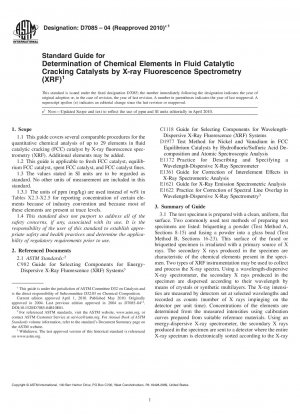ASTM D7085-04(2010)e1
Standard Guide for Determination of Chemical Elements in Fluid Catalytic Cracking Catalysts by X-ray Fluorescence Spectrometry (XRF)
- Standard No.
- ASTM D7085-04(2010)e1
- Release Date
- 2004
- Published By
- American Society for Testing and Materials (ASTM)
- Status
- Replace By
- ASTM D7085-04(2018)
- Latest
- ASTM D7085-04(2018)
- Scope
The chemical composition of fresh FCC catalyst and equilibrium FCC catalyst is a predictor of catalyst performance. The analysis of catalyst fines also provides information on the performance of the FCC unit and the fines collection device(s).
The chemical composition of equilibrium FCC catalyst is a measure of the hazardous nature or toxicity of the material for purposes of disposal or secondary use.
1.1 This guide covers several comparable procedures for the quantitative chemical analysis of up to 29 elements in fluid catalytic cracking (FCC) catalyst by X-ray fluorescence spectrometry (XRF). Additional elements may be added.
1.2 This guide is applicable to fresh FCC catalyst, equilibrium FCC catalyst, spent FCC catalyst, and FCC catalyst fines.
1.3 The values stated in SI units are to be regarded as standard. No other units of measurement are included in this standard.
1.3.1 The units of ppm (mg/kg) are used instead of wt% in Tables X2.3-X2.5 for reporting concentration of certain elements because of industry convention and because most of these elements are present at trace levels.
1.4 This standard does not purport to address all of the safety concerns, if any, associated with its use. It is the responsibility of the user of this standard to establish appropriate safety and health practices and determine the applicability of regulatory requirements prior to use.
8.1 A test method example is provided for the analysis of nickel and vanadium in equilibrium FCC catalyst using either a wavelength or an energy-dispersive X-ray spectrometer and test specimens prepared by the pressed pellet technique.
8.2 This technique can be extended to other elements.
16.1 A test method example is provided for the analysis of nickel and vanadium in equilibrium FCC catalyst using either a wavelength or an energy-dispersive X-ray spectrometer and using test specimens prepared by the fused bead technique.
ASTM D7085-04(2010)e1 Referenced Document
- ASTM C1118 Standard Guide for Selecting Components for Wavelength-Dispersive X-Ray Fluorescence (XRF) Systems
- ASTM C982 Standard Guide for Selecting Components for Energy-Dispersive X-Ray Fluorescence (XRF) Systems
- ASTM D1977 Standard Test Method for Nickel and Vanadium in FCC Equilibrium Catalysts by Hydrofluoric/Sulfuric Acid Decomposition and Atomic Spectroscopic Analysis
- ASTM E1172 Standard Practice for Describing and Specifying a Wavelength-Dispersive X-Ray Spectrometer
- ASTM E1361 Standard Guide for Correction of Interelement Effects in X-Ray Spectrometric Analysis
- ASTM E1621 Standard Guide for X-Ray Emission Spectrometric Analysis
- ASTM E1622 Standard Practice for Correction of Spectral Line Overlap in Wavelength-Dispersive X-Ray Spectrometry (Withdrawn 2006)
ASTM D7085-04(2010)e1 history
- 2018 ASTM D7085-04(2018) Standard Guide for Determination of Chemical Elements in Fluid Catalytic Cracking Catalysts by X-ray Fluorescence Spectrometry (XRF)
- 2004 ASTM D7085-04(2010)e1 Standard Guide for Determination of Chemical Elements in Fluid Catalytic Cracking Catalysts by X-ray Fluorescence Spectrometry (XRF)
- 2004 ASTM D7085-04e1 Standard Guide for Determination of Chemical Elements in Fluid Catalytic Cracking Catalysts by X-ray Fluorescence Spectrometry (XRF)
- 2004 ASTM D7085-04 Standard Guide for Determination of Chemical Elements in Fluid Catalytic Cracking Catalysts by X-ray Fluorescence Spectrometry (XRF)
